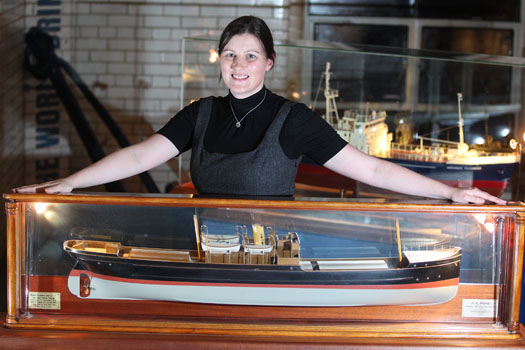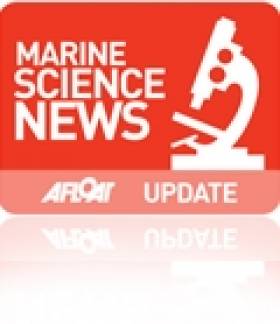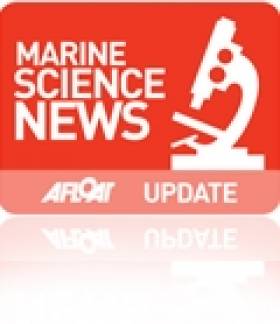Displaying items by tag: INFOMAR
INFOMAR Maps Out Proposed Operations for 2013
#INFOMAR – The Integrated Mapping for the Sustainable Development of Ireland's Marine Resource, in short (INFOMAR) have outlined their proposed mapping operations for 2013.
INFOMAR (covering 125,000 sq kms) is a joint venture between the Geological Survey of Ireland (GSI) and the Marine Institute.
During the current year of INFOMAR Phase 1 (2006-2016), operations are provisionally planned to take place within tabulated bays subject to approval from other agencies.
To see a map of proposed working area and more, Inshore Ireland (February / March) issue has a report.
As previously reported on Afloat.ie, the GSI's survey vessel RV Keary last month returned to service, having completed modifications carried out at Arklow Marine Services. The 15m aluminium catamaran research vessel was built in South Africa and is equipped with a full geographical suite.
Poolbeg Yacht Club to host Lecture on "Captain Bligh"
#LECTURE – Captain Bligh is the topic of the next lecture organised by the Dublin Bay Old Gaffers Association, held in the Poolbeg Yacht & Boat Club, Dublin Port on 20 November.
The illustrated talk (8pm) is to be presented by Sean Cullen, Senior Hydrographer, INFOMAR and whose predecessor was the Irish National Seabed Survey.
In addition limited copies of a new stunning publication "Warships, U-Boats & Liners - A Guide to Shipwrecks Mapped in Irish Waters" will be made available to purchase. The book which was launched today, showcases some of the more spectacular and important shipwrecks in Irish waters.
All are welcome to attend the DBOGA lecture programme noting there will be a door contribution for the RNLI.
Sonar Survey Reveals Torpedoed Guinness Ship
The detailed seabed images, which include deck features and complex sand wave structures, were recorded by towed sidescan sonar provided by the Moore Marine Group, and give a visual insight into the defensively armed ship that was sunk by a German torpedo in 1917, seven miles east of the Kish Bank off Dublin.

Photos above and below show topographic seafloor images in 3D, showing the partially buried wreck of the W M Barkley lying at a water depth of 56 metres; with deeper scouring around it down to 72 metres (darker colours indicate greater depths). The images were created from sonar data acquired onboard the Marine Institute's research vessel RV Celtic Voyager, during INFOMAR Programme mapping in 2010 and 2011 with data processed by INFOMAR's Fabio Sacchetti (University of Ulster) and Charise McKeon (Geological Survey of Ireland).

In May 2010, during a large scale mapping survey in the Irish Sea by INFOMAR, a national marine study run by the Marine Institute and the Geological Survey of Ireland, identified a seabed feature which, to the trained eye, was discernable as a potential shipwreck lying in the same position recorded on the Admiralty Chart, the EU wreck site and UK Hydrographic Office wreck site directories, as well as a survey conducted in the 1980s as the last known position of the W.M.Barkley.
Viewing the spectacular imagery of the shipwreck Minister for Communications, Energy & Natural Resources, Pat Rabbitte, said "I am delighted to note the continued excellence of the valuable work being carried out under the INFOMAR project. These images from the deep reveal a unique view of part of Ireland's marine heritage and I am delighted to announce details of INFOMAR''s annual seminar to be held in Galway on November 16 and 17th."

Eibhlin Roche - Guinness Archivist, Guinness Storehouse with the model of the W.M. Barkley. Photo: Jason Clarke Photography
Ninety four years ago on the dark night of October 12th 1917 the W.M.Barkley was torpedoed without warning by the German submarine UC-75. Within minutes the ship, which was owned and operated by the Guinness Company of Dublin, broke in two and sank, taking with her to the bottom four men including her Captain and leaving the rest of her crew to face the sea in an open lifeboat. Now, the darkness where the ship has lain in pieces has been disturbed, probed by fingers of sound that are mapping the seabed in incredible details and bringing to light the position of this famous Irish shipwreck.
"As the first Guinness owned ship, the W.M. Barkley played an important role in the story of the transportation of GUINNESS beer overseas," said Eibhlin Roche, Guinness Archivist. The events of the night of 12th October 1917 are very much part of the history of Guinness that is recorded in the Guinness Archive. It is exciting to finally know the exact resting place of the W.M. Barkley."
A scale model of the W.M. Barkley is on display in the Transport Gallery of Guinness Storehouse remembering the lives of the Guinness men who both perished and survived the events of 12th October 1917. These are stories of tragedy and bravery portraying Irish traditional values, and how they were brought to light with the application of cutting-edge technology.

Koen Verbruggen (GSI), Minister Pat Rabbitte, Dr. Peter Heffernan (CEO, Marine Institute), Eibhlin Roche (Guinness Archivist, Guinness Storehouse) and David Smith (Country Director, Diageo Ireland) Photo: Jason Clarke Photography
Waterford: Where Tallships and Science Meet
This was the RV Keary's first INFOMAR survey leg of 2011 and it was also the first time that both vessels have worked in tandem. The mapping of the estuary was from an area just west of the city's Rice Bridge to the open sea at the mouth of Waterford Harbour.
The estuary was mapped before in 2007 using the Marine Institutes larger vessel the RV Celtic Voyager, which covered the harbour approaches from the 10m contour to greater depth offshore. Both RV Keary and RV Geo overlapped their coverage with this previous data, producing a comprehensive and seamless seabed map of the area.
RV Keary is constructed of marine grade aluminium and was custom built in 2008 for the (GSI) by Veecraft Marine of Capetown, South Africa.
The 15m craft with a draft of just 2m is equipped with an extensive range of highly sophisticated technology. She has an open working area at the aft-deck to conduct operations and is licensed to carry up to 12 personnel. For further vessel characteristics click HERE.
The 34-tonne craft made her 7,000 mile delivery voyage from the African continent to Europe. She was firstly transported on the deck of a cargoship to Rotterdam. After unloading at the Dutch port the 22-knot capable craft set off with several calls along the UK south coast to include loading bunkers before finally reaching Dun Laoghaire, from where she entered service in April 2009.
Irish 'Underwater Atlas' Launched at Geoscience Event
Following the publication of 'The Real Map of Ireland', showing a three-dimensional overview of Ireland's seabed territory, earlier this year comes 'The Real Atlas' – a detailed compilation of stunning three-dimensional imagery featuring the submarine canyons, underwater mountains and abyssal plains that make up Ireland's seabed territory, an area ten times that of our land mass.
This publication, Atlas of the Deep Water Seabed, Ireland was unveiled today (Wednesday 3rdth November) by Minister of State at the Department of Communications, Energy and Natural Resources, Mr. Conor Lenihan, T.D. at the Geoscience 2010 conference in Dublin Castle. It has been compiled by University College, Cork from data gathered as part of the Irish National Seabed Survey (INSS) and INFOMAR inshore seabed survey undertaken by the Geological Survey of Ireland (GSI) the Marine Institute and partners,
Speaking at the opening of the event Minister Lenihan said, "This is the first such Atlas of its kind world-wide, reflecting our leading role in this field. It will be a valuable resource as we seek to utilise our vast ocean resources in the years ahead. As we develop ocean energy, offshore wind and further oil and gas prospecting, an accurate map of the deep seabed will be vital."
The first day of the conference focused on what has been described by European Commissioner for Research, Innovation and Science, Maire Geoghegan-Quinn as one of the "grand challenges for the 21st Century" – the seas and oceans. It featured detailed papers on seabed mapping, deepwater coral reefs, deepwater remotely operated vehicles and a virtual computer simulation of Galway Bay.
3D image of the 300 km-long Gollum Channel system off the Porcupine Seabight, extending from the edge of the Seabight right down to the Porcupine Abyssal Plain.Image by B. Dorschel with kind permission from Springer Science+Business Media B.V.
First day speakers from the Marine Institute included Fabio Sacchetti, who described the mapping of the Rockall Trough, and Tommy Furey who discussed the value of seabed mapping projects to a wide variety of marine industries. The first day's proceedings also included a paper by Dr Colm Lordan of the Marine Institute's Fisheries Science Services team on the value of the INFOMAR seabed survey to the Irish fishing industry, and an important paper by the Marine Institute's Director of Strategic Planning and Development Services, Yvonne Shields entitled "Irish Marine research in the Bigger Picture."
The second day of the conference, will focus on more terrestrial themes includes papers on new findings in relation to Irish offshore basins from researchers at UCD.
Full details of the event, including the programme of speakers, are available from:
http://www.gsi.ie/Geoscience+Initiatives/Geoscience+2010+Conference.htm
Atlas of the Deep Water Seabed, Ireland can be ordered directly from amazon.co.uk at:




























































